,-2014.jpg)
Oksana Chepelyk. Лист з України / Letter from Ukraine, 2014. Film, HD (1920 x1080 px), colour, sound, 7:32 min. © Oksana Chepelyk. Courtesy of the artist.
by LILLY WEI
“The village of my postwar childhood was a village of women … I don’t remember any men’s voices. That is how it has remained for me: stories of the war are told by women.” This observation was made by the Belarusian journalist, writer and winner of the 2015 Nobel Prize in Literature, Svetlana Alexievich, in her book The Unwomanly Face of War. It was quoted by Monika Fabijanska in her text for Women at War, the exhibition she curated at the Fridman Gallery in New York. It aptly describes the show, which introduces some of today’s leading female Ukrainian artists to the United States at a time when a devastating war is raging in their country. Several works in the exhibition were made after the 24 February invasion by Russia while other works date from the eight years of war following the annexation of Crimea and the creation of the separatist republics of Donetsk and Luhansk in 2014. War has usually been a subject reserved for men; in this exhibition, it is female artists who narrate its stories. This exhibition also provides insights into eastern European feminism and its history, which is markedly different from that of western Europe.
The following is an excerpted, edited conversation with Fabijanska.
Lilly Wei: How did this exhibition come about? It must be more difficult than usual to organise such a show, with a country in the grip of war and an ongoing pandemic – which makes it even more important that people see it.
Monika Fabijanska: Iliya Fridman [founder and director of the Fridman Gallery] asked me to be the curator-in-residence and to curate a summer show for his gallery. When the war in Ukraine broke out, he asked me to curate a show of Ukrainian artists. He had been working with the Voloshyn Gallery, one of the most prominent in Kyiv, currently with a pop-up gallery in Miami and they were looking for opportunities to show their artists in New York. So, it was Iliya who made it possible as well as Voloshyn.
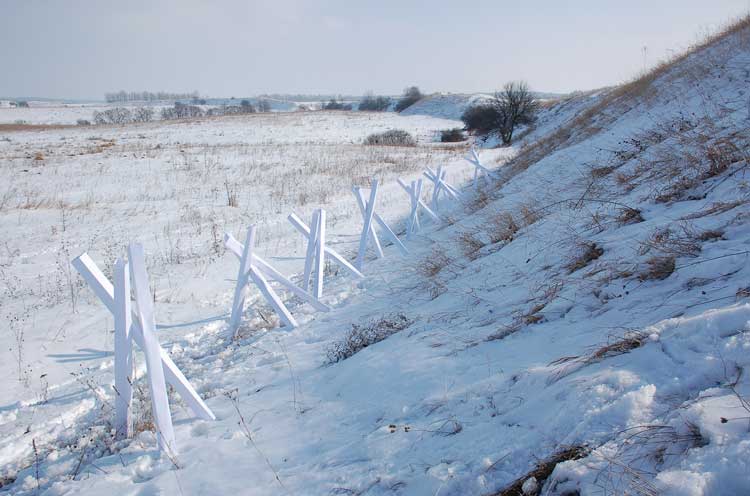
Olia Fedorova. Defense, 2017. Photograph, archival inkjet print documenting site-specific paper sculpture, 30 x 45 in. © Olia Fedorova. Courtesy of the artist.
LW: You have said your first reaction was reluctance. Why?
MF: It was a matter of time. Curating an exhibition about war would be very challenging, and because I come from eastern Europe, I could not take this project lightly.
LW: But since you had access to the artists, that must have been an incentive?
MF: Yes, it was. And Iliya was dedicated to this show. I also have easier access to research materials because I can read Polish and Ukrainian. I was also on my way to Venice and Warsaw, so I could scout possibilities in Europe and bring work back with me to New York or arrange it from there. After considering that, I realised we were in a unique position and the show would not be haphazard. When I said yes to Iliya’s proposal, I had four months to organise the show. The war would still be on, I believed.
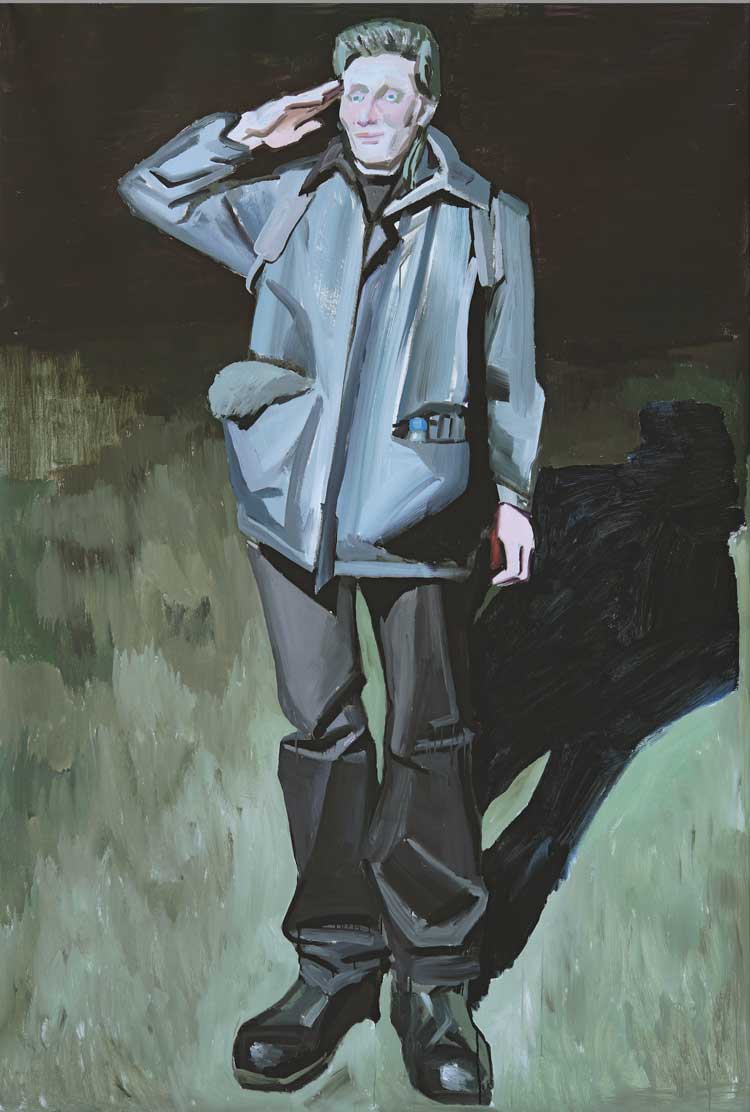
Lesia Khomenko, Max in the Army, 2022. Oil on canvas, 84.5 x 57.5 in. © Lesia Khomenko. Courtesy of the artist.
LW: You were right. It still is. You were prescient, since so many commentators, if not most, thought Russia would make short work of Ukraine.
MF: Yes, and the summer timing meant the show could be an opportunity to keep people’s focus on Ukraine, and in a new way. I wanted Americans to become better acquainted with the culture and I hoped that the exhibition would do this, keeping the focus on them as attention waned.
LW: Attention spans are so short, as is the news cycle, but this was unexpected. No one would have thought the Ukrainians could have held on this long. How did you choose the artists, who are all women? As the provocative title, Women at War, tells us, it is a kind of reversal since it is more often men who are at war.
MF: One condition of the show was that it had to be feminist because I am a feminist curator. I also had to find a theme that was bigger than the war in Ukraine, something more universal to engage people who didn’t have any particular interest in the region. The theme of the exhibition is feminist historiography: how women experience the war, how they see it, and how they record it. Without any preconception of the answers these questions would bring.
LW: You said you considered more than 50 artists for this show and selected 12.
MF: Yes; 11 are contemporary, some of Ukraine’s best, with one historical artist, Alla Horska, to provide background and a legacy. A fiercely dedicated activist, Horska was murdered in 1970, at the age of 41, presumably by the KGB. One of my first thoughts in curating this show was that it should explain a war that has been going on in Ukraine in silence for eight years, since the invasion of Donbas in 2014. Because of that, there is a plethora of works on war. The works here consist of almost equal numbers made after this past February and the full-fledged Russian invasion and from post-2014. Together, they give a more complete picture.
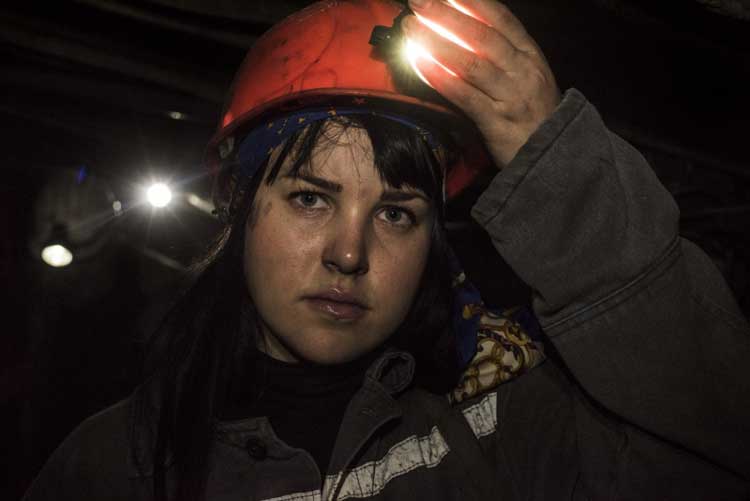
Yevgenia Belorusets, Victories of the Defeated, 2014-18. Archival inkjet print mounted on dibond, 10 x 15 in. © Yevgenia Belorusets. Courtesy of the artist.
LW: Looking at the show, I see that not all the works refer directly to the war.
MF: Yes, that was intentional. Some speak directly about the fate of women during the war, such as women hiding in cellars for months after giving birth to protect themselves and their newborns from the ongoing shelling in Alena Grom’s inkjet prints or Oksana Chepelyk’s allegorical video of a mother and child racing in fear through the convoluted streets of an old city. Some refer to fates determined by gender roles. For example, men [aged 18-60] are not allowed to leave Ukraine now, while women, especially mothers of small children, are encouraged to leave. Another is rape, although both men and women are raped. There is widespread rape occurring, another form of killing. And rape is a historical tool of war, not just in Ukraine. As one of the devastations of war, Dana Kavelina’s drawings point out that there is the crossing of bloodlines because of rape, so the blood of the enemy can also become the blood of your child.
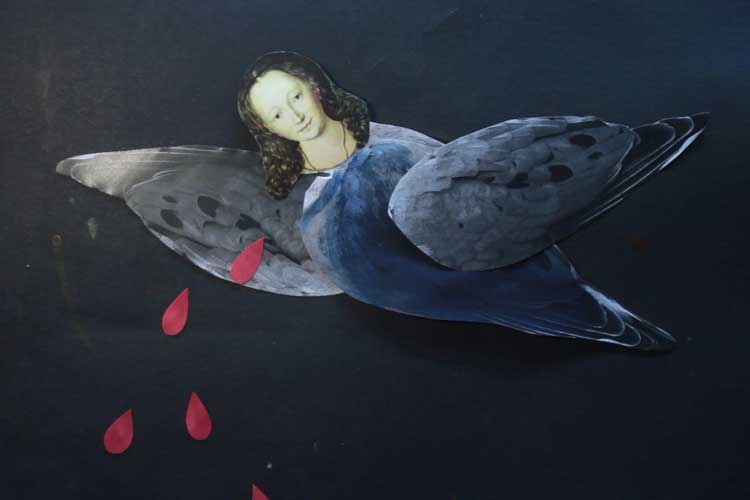
Dana Kavelina, Letter to a Turtledove, 2020. Flm still. HD, colour, sound, 20:55 min. © Dava Kavelina. Courtesy of the artist.
LW: Kavelina, who was born in 1995 in the now Russian-occupied city of Melitopol and is in Germany, I was told, talks about the subjectivity of history and whom “we empower to make a record”.
MF: Yes, her very feminist proposal has it that history should be written not by the winners, but by the defeated, and reflect the conflicting narratives. The works in the show focus on women’s perceptions. Women in this exhibition don’t focus on the winners but on the defeated, on the life in a war that is invisible and usually overlooked by journalists. They see old people, workers, animals, those who can’t leave – they don’t have the resources to leave, or they can’t leave their homes emotionally – and they end up in the middle of a war. Many of these artists focus on them, on the people who are left there.
LW: Could you talk about the work of an artist or two as an example of that?
MF: Alevtina Kakhidze’s ink drawings represent her mother’s plight. She was among half a million Ukrainian pensioners living in the separatist territories, who registered as displaced persons in Ukraine in order to receive their pensions – which required crossing the demarcation line several times a month. She lived in a small village with a garden so she could survive on its produce, and she would go a few times a month to retrieve her money. Although the subject is serious, there is also black humour involved – people naturally need it when they are bombarded, their homes destroyed, their lives upended. Alevtina’s drawings are also humorous, such as the irony of her mother calling her daily from the local cemetery, which was the only place in the village that still had any mobile connection, to tell her she is all right.
LW: Curious that a cemetery would have the best access – a direct conduit to a higher power, perhaps?
MF: Perhaps. Humour helps them survive.
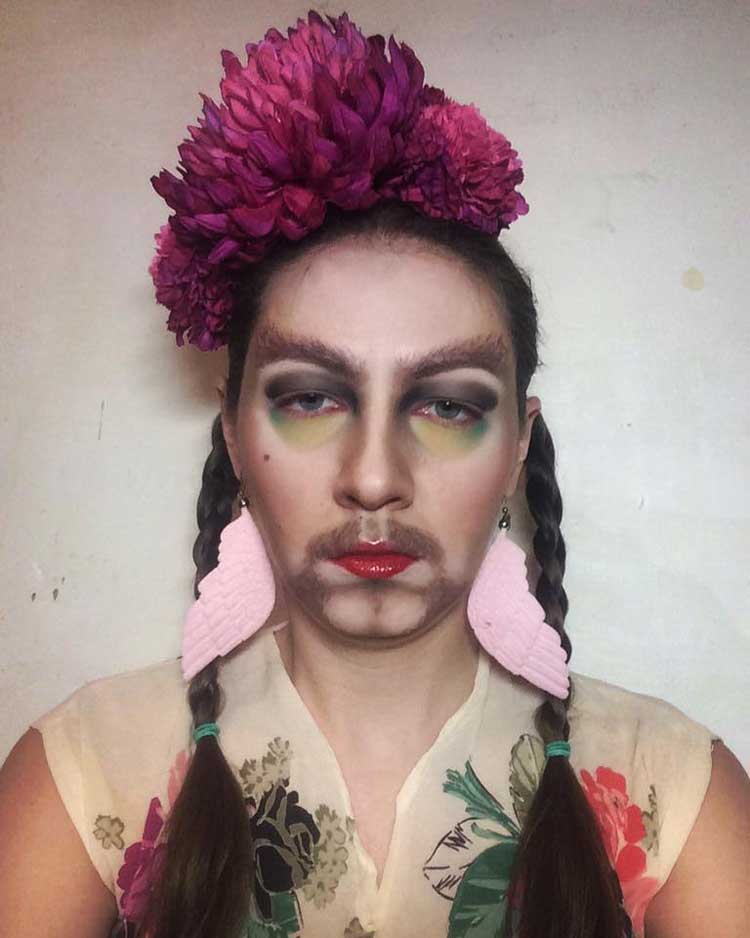
Kateryna Yermolaeva, Photo No2, 2018. Inkjet print, 8.3 x 6.7 in. © Kateryna Yermolaeva. Courtesy of the artist.
LW: And the artists whose work are not directly about the war. Would you discuss one such artist?
MF: An unexpected work might be Kateryna Yermolaeva’s photographs of herself as a non-binary trans-dresser. When she lost her home in Donetsk when it was taken over by separatists, she lost everything. And to contextualise what that means in Europe, especially in eastern Europe, you must understand that people stay put in one place for generations and, even if displaced by war, people will return, or simply won’t leave. It’s extremely painful to lose the home where your family has lived for generations. In 2015, she had completed a major installation at the PinchukArtCentre in Kyiv about displacement, but afterwards, a severe depression set in. She went on to experiment with the image of herself in traditional gender roles, then as non-binary persons, and finally as a multiplicity of persons and posted the photos online. She speaks about the mental price that war extracts. Its impact will inevitably change you and the society you live in. The intensity of experiences differs but it is shattering, and with it comes loss and insecurity about the future.
LW: As these artists repeatedly say, war is not about the victorious because there are no victors in a war.
MF: Most of the artists are politically active with a focus on human rights. They offer a critique of officialdom, of glorifying war as heroic in a style that is associated with academic traditions in painting, including in Soviet art. A feminist record – and therefore historiography – of war is different. It focuses on the defeated, not on the victorious because, in their opinion, wars have no victors. Also, women's experience and perception of the war is still largely different from that of men. As I look at the show, I see more and more layers in it.
LW: What is the main thing you would like viewers to take away from Woman at War?
MF: I’d like them to know that there is a very strong art scene in Ukraine that is culturally specific and quite different from Russian art. They have their own culture and dreams and, often, that dream is about independence and about an identity that is their own, without the threat of annexation, invasion and annihilation. I hope other curators take note and create more exhibitions dedicated to Ukrainian artists.
• Women at War, curated by Monika Fabijanska, is at the Fridman Gallery, New York, until 26 August 2022.